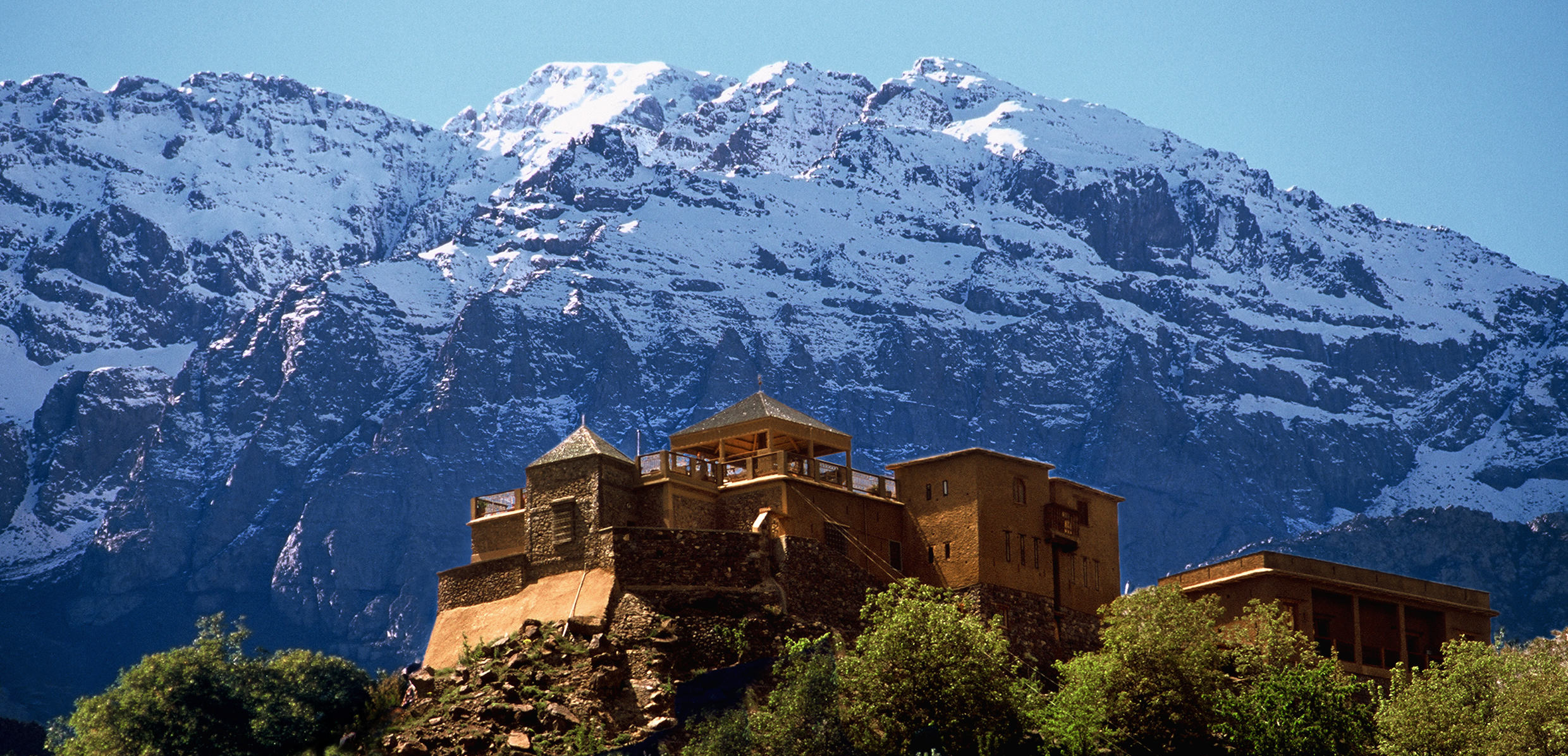The Taxi whisked Cheeky and I out of Marrakesh and across the flat, arid landscape. Eventually in the distance through the haze, the High Atlas Mountains loomed. It was to be an hour and thirty minutes drive, that took us from flat barren land to red rocky hills with towns clinging to hillsides and eventually dry rocky mountains with every valley teaming with green lush vegetation. We travelled along winding mountain roads and through little mountain villages until we were in the Imlil Valley where the Kasbah du Toubkal is situated. Eventually we reached the drop off point, where we had arranged to meet our guide with his mules, the mules were to carry our luggage the rest of the way to the Kasbah. Due to an earlier injury Cheeky was able to hop on a mule when the going got a little too steep and uneven, which of course provided some great photo opportunities. After about fifteen minutes we had arrived at our final destination, which I am sure the mules were glad of too.We were invited in through what felt like a tiny castle keep, and up the steep stairs and into the beautiful gardens of Kasbah du Toubkal. It was mid October, the skies were blue and the flowers were in full bloom; being at 1800 metres above sea level the temperature was a relief from the dry heat of Marrakech and the mountain air was a pleasure to breath. As our luggage magically made its way to our room we were invited into the main part of the Kasbah and as Berber tradition dictates we were invited to wash our hands in rosewater and partake in dates dipped in milk and relax with a drink. Once settled in, we checked into our charming and delightfully rustic suite which came with traditional Berber tunics and slippers to keep us warm during the mountain nights. However, it was that time of day when my stomach starts to speak up, so it was time to take it to the roof of the Kasbah!Once we emerged on the roof terrace, we were faced with spectacular 360 views of the whole valley sprawling out below and the mountains looking overhead, with the famous Jbel Toubkal meaning ‘Top of the Mud’ standing at 4167 metres, the tallest mountain in North Africa sitting majestically at the end of one of the valleys. This was an area we were to spend much time taking in the breathtaking views and letting the clean air cleanse our bodies. Lunch was served and it was Tagine time, with chicken and vegetable tagine and turkey kebabs all with homemade traditional bread. All the meals at the Kasbah are wholesome and pretty filling like good alpine fare should be, to set you up for mountain pursuits. In traditional style most of the food is cooked to perfection in a tagine and is usually served with plenty of vegetables, rice and the most amazing homemade chips. Dinner is served inside the Kasbah, by candlelight, which makes for a very unique and authentic experience. It was always a pleasure turn up for the food and the warm Berber hospitality at the Kasbah.The next day it was time to take a hike! The area has many trails and it can be quite easy to get lost in the peaks or even in the villages which are literally labyrinths, so we took a guide. He took us on a two hour hike up away from the Kasbah in the direction of Jbel Toubkal, and then through the village of Aroumd. Berbers tend to be gifted with learning languages and most who work in tourism, which accounts for about 50% of local industry, speak about three different languages. Our guide took us through the orchards where many of the local Berbers were toiling away harvesting the local crops of Cherries, Walnuts and Apples which filled the valley with a beautiful smell of fresh fruit. Farming constitutes for the other 50% of local industry. Sadly parts of the town suffered with a lot of rubbish which apparently is not from tourism but the locals, but things are changing due to education of its impact on the environment. Since Kasbah du Toubkal opened as a tourist destination about 30 years ago, it has brought with it several benefits to the local population from building five boarding houses for local girls to receive local education, to creating a local association that deals with such issues as garbage disposal and clean water and it goes without mentioning as a National Geographic ‘Unique Lodges of the World’ the Kasbah draws a lot of tourism to the area which in turn brings a lot of employment and financial support to the local valleys. We finished our hike with a rest by a peaceful waterfall and the best mint tea experienced yet on our travels in Morocco, then a serene stroll back through the glades along the aqueduct to the Kasbah. This was one of many trails that one can take in the area, along with a two day hike to the top of Jbel Toubkal and other longer trails though the mountains, though guides are a must, as there are regular deaths on the mountain as it easy to get lost.Kasbah Toubkal is a unique place, with stunning views to relax the mind and feed the soul in rain, shine or snow, but no matter the weather the Berbers are a very warm and light hearted people who are as quick to smile as they are to help locals and tourists. Toubkal translates as ‘Top of the Mud’ which I kind of like, because it is so much more than a pile of mud! Martin Scorsese filmed his 1997 movie ‘Kundun’ at the Kasbah, where it was converted into a Tibetan monastery with good reason; for when one enters the area, one could be forgiven for thinking that one had just stepped into the mountains of Tibet. This is a particularly special part of the planet that I would love to revisit for much longer to explore more of the surrounding mountains and experience more of the fantastic Berber culture.
Kasbah du Toubkal
Gite Toubkal
Imlil 40000
Morocco


